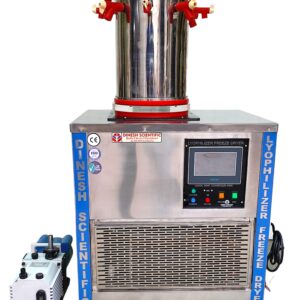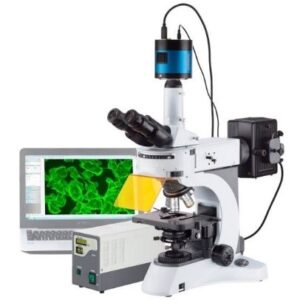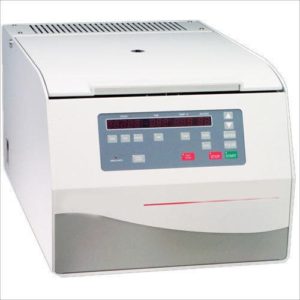REFRIGERATED MICRO-CENTRIFUGE
MAKE DINESH SCIENTIFIC
DESCRIPTION:
With the use of centrifugal force, materials with varying densities can be separated in a sophisticated laboratory device called a chilled centrifuge. It works on the idea that the denser particles in a sample travel outward and form different layers when it is spun rapidly. The following is a thorough explanation of a chilled centrifuge:
A sophisticated laboratory tool called a chilled centrifuge is used to separate particles according to their density from a liquid mixture. Centrifugal force is utilized by this apparatus to quickly spin samples in a temperature-controlled setting, usually between sub-ambient and room temperature.
FEATURES :
- Benchtop Refrigerated Centrifuge:
- Robust C.R.C. structure with powder-coated finish
- A centrifugal bowl made of stainless steel for added protection and simple cleaning.
- Equipped with an electronic drive and a well-balanced brushless motor.
- 20 characters in 4 lines. LCD display for rpm, CF, set and run times, and set times
- There is an automated dynamic brake and an imbalance detector.
MAIN COMPONENTS:
- ROTOR: The sample tubes or containers are held in place by the centrifuge’s rotor. It creates centrifugal force by spinning quickly.
- MOTOR: The rotor is driven by a strong motor, which enables high rotation rates
- CONTROL PANEL: Users can adjust centrifuge process parameters like speed, temperature, and duration via the control panel.
REFRIGERATION SYSTEM:
- This feature separates a conventional centrifuge from a chilled one. It has a cooling system that keeps the centrifugation temperature low, which is essential for protecting the integrity of samples that are sensitive to temperature changes.
FUNCTIONALITY:
- CENTRIFUGATION: The main purpose is to rotate the samples quickly such that the denser components settle to the bottom of the tubes.
- REFRIGERATION: The centrifuge’s internal temperature is regulated by an integrated refrigeration system, which permits sample separation without jeopardizing the integrity of materials that are sensitive to temperature changes.
APPLICATIONS:
- CELL SEPARATION: Cells are divided according to density in biological research.
- PROTEIN PURIFICATION: vital for separating and purifying proteins from complicated mixtures in biological investigations.
- DNA AND RNA EXTRACTION: helps to separate nucleic acids from biological materials more easily.
- CLINICAL DIAGNOSTICS: utilized in clinical labs for a range of diagnostic procedures, including the separation of blood components.
TEMPERATURE CONTROL:
- Depending on the model, the refrigeration system can normally regulate the temperature between below ambient and below zero.
SAFETY FEATURES:
- LID LOCKING MECHANISM: Makes sure the centrifuge lid stays firmly closed while it is in use.
- AUTOMATIC IMBALANCE DETECTION: In the event of an imbalance, stops the centrifuge to protect the samples and the device.
CAPACITY AND SPEED:
- SAMPLE CAPACITY: To handle a variety of sample sizes and kinds, refrigerated centrifuges are available in a range of sizes and rotor designs.
- SPEED CONTROL: Users can adjust the centrifugation settings for various applications using variable speed control.
USER INTERFACE:
- Digital Display: For convenient monitoring of the settings, remaining time, and speed, the control panel usually has a digital display. In conclusion, a refrigerated centrifuge is a multipurpose laboratory instrument that combines temperature control and centrifugation principles, allowing scientists to precisely separate and analyze samples, particularly when working with materials that are sensitive to temperature.
TECHNICAL DETAILS:
| MODEL | DS-RC-SAR |
| Aerosol Tight Rotor | Possible to use aerosol tight rotor |
| System Speed | 30,130xg / 17,500 rpm, brushless motor |
| Temperature Range | -11°C to 40°C, maintains 4°C at speed |
| Rotor Type | Capable of using fixed angle rotor |
| Model Dimensions | Compact benchtop, not exceeding 15x15x20 in. (HxWxD) |
| Tube Capacity | Accommodates 48 x 1.5/2mL tubes |
| Rotor for Strips | Available for 0.2ml strips |
| Program Storage | Capable of storing 50 programs with 5 quick access program keys |
| Rapid Cooling Function | Fast temperature function for rapid cooling |
| Condensate Drain | built-in condensate drains to stop water buildup |
| Compressor Shut Off | Programmable to shut off after 8 hours of non-usage |
| Programmable Temperature Function | Enables precooling automatically with reprogrammable date and time |
| Rotor Material | Aerosol tight lids and metallic autoclavable rotors are included. |
| Speed Setting | Possible in both RPM and RCF |
| Acceleration/Deceleration | Gentle acceleration and deceleration using dedicated key |
| Short Spin Key | Separate key for brief spin with user-defined speed |
| Automatic Rotor Recognition | Detects and adjusts speeds automatically as the rotor changes. |
| Rotor Flexibility | Accommodate rotors for different tube formats starting from 0.2mL PCR tubes to spin column tubes |
| Timer Function | Timer supports brief spin techniques by starting only when the predetermined centrifugation RPM is attained. |
| Rotor Lids | Rapid Lock mechanism for rapid rotor lid opening and closing |
| Operation Menu | Menu-driven, multilingual operation with large backlit display |
| Lock Function | Prevents program settings from being overwritten or changed |
| Noise Levels | <54 dB(A) for quiet operation |
| Extended Display | Shows both set and current parameters |
| ROTORS | |
| Rotors | 1. Fixed angle rotor for 24/48 x I .5/2.0 mL tubes with speed of 14,000rpm and 20,800 x g, and for PCR strips 0.2 ml
2. Rotor bore 450 angle to minimize the pellets smear along the tube walls |















Reviews
There are no reviews yet.